ePostcard #121: Cold Stunning
Photo Credit: Courtesy of Miguel Roberts/The Brownsville Herald (MIGUEL ROBERTS AP) Thousands of Atlantic green sea turtles and Kemp’s ridley sea turtles suffering from cold stun are laid out to recover Tuesday, Feb. 16, 2021 at the South Padre Island Convention Center on South Padre Island, Texas.
February 17, 2021 South Padre Island, Texas. Yes, you are reading the date correctly. I learned about what was happening in Texas yesterday afternoon. I’ve copied the day’s news report from The Brownsville Herald below:
Residents, some of whom lack heat or basic amenities in their own homes due to the unusually chilly weather, have been rescuing cold-stunned sea turtles and taking them to a convention center in a South Texas resort town.“Every 15 minutes or less there’s another truck or SUV that pulls up,” Ed Caum, executive director of the South Padre Island Convention and Visitors Bureau, told The Associated Press on Wednesday. He said sometimes people bring in one or two sea turtles, sometimes more. “We had trailers coming in yesterday that had 80, 100, 50,” he said.
The South Padre Island Convention Center started pitching in Monday when it’s neighbor, Sea Turtle Inc., could no longer handle the number of sea turtles being dropped off, and their mostly outdoor operation had lost power. He said the convention center itself didn’t have power or water till early Wednesday morning. They’ve “collected” more than 3,500 sea turtles so far. He said he hesitates to use the word rescued because “we know we’re going to lose some.”
Caum said that with another cold front approaching, they don’t know when they’ll be able to return the sea turtles to the water. Temperatures in the area on Wednesday afternoon were in the 40s. He said it may be Saturday — when temperatures are expected to reach the low 60s (above 15 Celsius) — before the turtles can be released back into the Gulf. He said that with power returned they have been able to bring the convention center’s temperature to 60 degrees. “We’re trying to do the best we can to save as many turtles as possible,” he said.
[Read more here: https://www.tri-cityherald.com/news/business/health-care/article249318315.html#storylink=cpy]
click images to enlarge
Photo Credit: NPS Padre Island National Seashore (Texas Gulf Coast). This turtle is about to be rescued.
Climate change doesn’t just cause warming. It also affects ocean circulation and currents, which are the highways that sea turtles use for migration. With profound changes occurring in ocean circulation, sea turtles may be shifting their movements and possibly their range and nesting timing. When they do this they may end up being “trapped” in areas with lower water temperatures, which prevents them from departing. When sea turtles are exposed to cold temperatures for long stretches, it can cause cold-stunning events. Cold-stunned turtles are typically found hypothermic and stranded on the beach, a condition few survive. A study by researchers at the University of Massachusetts showed that cold-stunning and stranding events among juvenile Kemp’s ridley sea turtles are increasing at an “alarming” rate. Researchers have yet to reach consensus on how climate change will further affect sea turtle cold-stunning events but agree that “climate change may present the broadest threat among many to sea turtle conservation.”
A cold stunned sea turtle is one that has become hypothermic due to severe cold weather. Like all reptiles, sea turtles (with the exception of the leatherback) are ectothermic (cold-blooded) and cannot regulate their own body temperature. If water temperatures drop below approximately 50°F (10°C), sea turtles become lethargic and are unable to swim. They float up to the surface and become vulnerable to boat strikes or wash ashore and become stranded. If not rescued quickly, they often die of shock, predation, or physiological trauma. Most of the cold stunned sea turtles that the Division of Sea Turtle Science and Recovery at Padre Island rescues are found in inshore waters and on shorelines along the bays and inlets of Laguna Madre, which borders Padre Island National Seashore to the west. The shallow water there can change temperature rapidly, especially when a strong cold front passes through the area. As a result, sea turtles swimming in those waters may not have enough time to navigate out of Laguna Madre and into the deeper, warmer waters of the Gulf of Mexico before becoming cold stunned.
The number of cold stunned green sea turtles found along the South Texas coast has increased significantly in recent years, likely for two reasons. First, the number, frequency, duration, and severity of cold weather events have increased. Second, the juvenile green turtle population in Texas has increased significantly, with many of them remaining in the area year-round. Padre Island National Seashore staff and volunteers proactively search for and rescue cold stunned sea turtles by patrolling the Laguna Madre on foot and by boat. Other federal agencies, state agencies, nonprofit organizations, and countless citizens are essential partners who play major roles in this effort every year. Lacking the facilities needed to house and care for live cold-stunned sea turtles, the turtles are taken to the park’s Turtle Laboratory for documentation and are then transported to specially designated, temporary holding facilities operated by partner organizations. These partners have the permits and facilities needed to care for and rehabilitate sea turtles. Without their expertise, many cold stunned sea turtles would not survive.
Cold stunned sea turtles are not held in captivity any longer than necessary. Once area waters have risen to safe temperatures and the individual turtles have recovered from hypothermia, they are released back into the wild. If they have other illnesses or injuries, they can rehabilitate until they are ready for release. The number of cold stunned sea turtles that strand varies from year to year depending on the number of turtles in the area and on the number, frequency, duration, and severity of cold weather events. If the winter is very mild, there may be few to no cold stunned turtles, but if there are several severe cold fronts over a short period of time, with each one lasting several days, hundreds to even thousands of turtles may strand.
Illustration Credit: This extraordinary illustration, which was the result of a collaborative effort between the National Aquarium and the Johns Hopkins Department of Art as Applied to Medicine, was drafted by student Katelyn McDonald.
The illustration above depicts the physical and physiological (the function of organs, tissues, and cells) effects of a cold stunning on sea turtles. Sea turtles are cold-blooded, meaning their body temperature relies on the temperature of their environment. Cold-stunning is essentially hypothermia (low body temperature). Cold-stunning events in the northeast region can cause chronic illnesses for turtles, and many must undergo months of rehabilitation. While the turtles may not appear sick externally, the illustration demonstrates the multitude of internal complications that result from chronic low body temperature. Once admitted for treatment, the turtles are gradually warmed over the course of a few days and provided fluid therapy, antibiotics and nutrition. Both short and long-term rehabilitation can be provided, and many sea turtles remain in rehab for 6-9 months before being cleared for release.
Photo Credit: Courtesy of Cape Hatteras National Seashore, Jeff Hampton and The Virginian-Pilot (https://www.pilotonline.com/news/vp-nw-turtles-stunned).
A young Kemp’s ridley sea turtle lies immobile along the shore after a sudden drop in temperatures this week. Outer Banks volunteers have rescued in the last couple months more than 200 young sea turtles immobilized by two different sudden drops in temperature.
Photo Credits: All 3 photos, the one above and the 2 below, are courtesy of New England Aquarium/Connie Merigo.
These are the sea turtle rehabilitation tanks at the New England Aquarium. The number of cold-stunning and stranding events among Kemp’s ridley sea turtles, one of the world’s most endangered species, is increasing at an “alarming” rate, say researchers led by Lucas Griffin at the University of Massachusetts at Amherst.
This year, 3 loggerheads and 17 Kemp’s ridleys, were among more than 800 in the New England area injured by cold temperatures. Research results strongly suggest that Kemp’s ridleys are especially vulnerable to stranding when water temperatures drop below 50.9 degrees Fahrenheit and, at the same time, when wind stress is intense in certain directions. As researchers point out, there is still much that remains unclear about the cold stunning-related strandings, such as the depth at which Kemp’s ridley turtles typically become hypothermic. The researchers hope that their ongoing work will help predict the key stranding locations of Kemp’s ridley sea turtles on Cape Cod beaches, which may guide search and rescue efforts in the future.
If the turtles are still alive when they are found, rescuers provide first aid before rushing them to the New England Aquarium’s Animal Care Center, where they will be assessed for hypothermia and related complications, like low blood sugar, pneumonia and a slow heart rate. “Sometimes we are seeing a heartbeat of one beat per minute,” according to Connie Merigo, director of the Aquarium’s Rescue Rehab program. “But that animal is still alive and, with emergency care, can go on to recover at a rehab facility in South Florida and be released.”
Caitlin Bovery, the sea turtle rehabilitation assistant coordinator at South Florida’s Gumbo Limbo Nature Center, was on the tarmac at the Boca Raton Airport waiting with her team on Monday as the turtle patients began arriving from the New England Aquarium. She described very vividly what it was like watching the turtle rescue planes (all volunteers) arriving, the 3 loggerheads and 17 Kemp’s ridleys among more than 800 cold stunned turtle patients from the New England area injured this year. Sea turtle rehab facilities across the country are part of the national effort to save these endangered species. “They’re so weak they can barely pick up their heads to breathe,” Bovery said.
By fitting sea turtles with satellite tags it is possible to track their journeys and see how their movements relate to sea surface temperature, currents and other oceanographic features. One of the manifestations of climate change is increasing sea surface temperatures, which have the potential to not only influence sea turtle distribution but also to alter sea surface currents. If sea turtles use these features in their trans-oceanic movements, changes could result in sea turtles using different foraging and nesting areas and remaining in those areas longer than they might otherwise.
What is happening in the Gulf of Maine that is driving the increase in cold stunning events and higher mortality rates from Cape Cod to the Texas Gulf? Researchers suggest that higher rates of cold-stunning (and more sea turtle strandings) occur when the Gulf of Maine has warmer sea surface temperatures in late autumn, namely late October through early November. Normal migratory patterns of the turtles involve following the Gulf Stream north from their hatching sites along the Gulf of Mexico. However, as the water warms farther north, the turtles venture farther into the Gulf of Maine and linger later in the season, placing them in a perilous position when temperatures drop precipitously in the fall. All hard-shelled sea turtle species are physiologically susceptible to cold stunning, and Kemp’s ridleys, greens, and loggerheads are found stranded more frequently. Of those three species, the critically endangered Kemp’s ridley sea turtle is the most frequently observed during the cold-stun season in New England and New York.
The geography of Cape Cod in relation to the Gulf of Maine makes it even harder for turtles to escape to lower latitudes once temperatures drop. Swimming south from the Gulf of Maine brings them into Cape Cod Bay, which is bordered to the south by a hooked peninsula. To leave the bay, the turtles have to swim back in the direction from which they came (north) and then east around the hook’s tip to warmer seas, but encountering the cold northerly waters confuses them. As one expert commented, “their instinct tells them to retreat back into the shallow warmer water of the bay and wait it out,” which ultimately leaves them trapped and in dire need of rescue and rehabilitation.
In the past decade, the Gulf of Maine has warmed 99% faster than the rest of the ocean. A recent study linked the warming to a northward shift in the Gulf Stream as well as changes in the Atlantic Multidecadal Oscillation and Pacific Decadal Oscillation. Apparently, as climate change melts Arctic ice around Greenland, the water becomes fresher and less dense, weakening the (colder) descending Labrador Current and allowing the (warmer) Gulf Stream current to push farther north into the Gulf of Maine. The gulf’s C-shape, shallow depth, and topography exacerbate the effects of these changes in ocean circulation by holding warmer waters in place longer than would a more free-flowing system. Continued changes in the physical oceanographic conditions that drive biological patterns of behavior, such as migrations, suggest that the plight of sea turtles stranded on Cape Cod may increasingly worsen in the years ahead.
click images to enlarge
To help build global awareness, we would appreciate it if you would share this post with your friends and colleagues. Please choose one of the options below which includes email and print! Thank you.

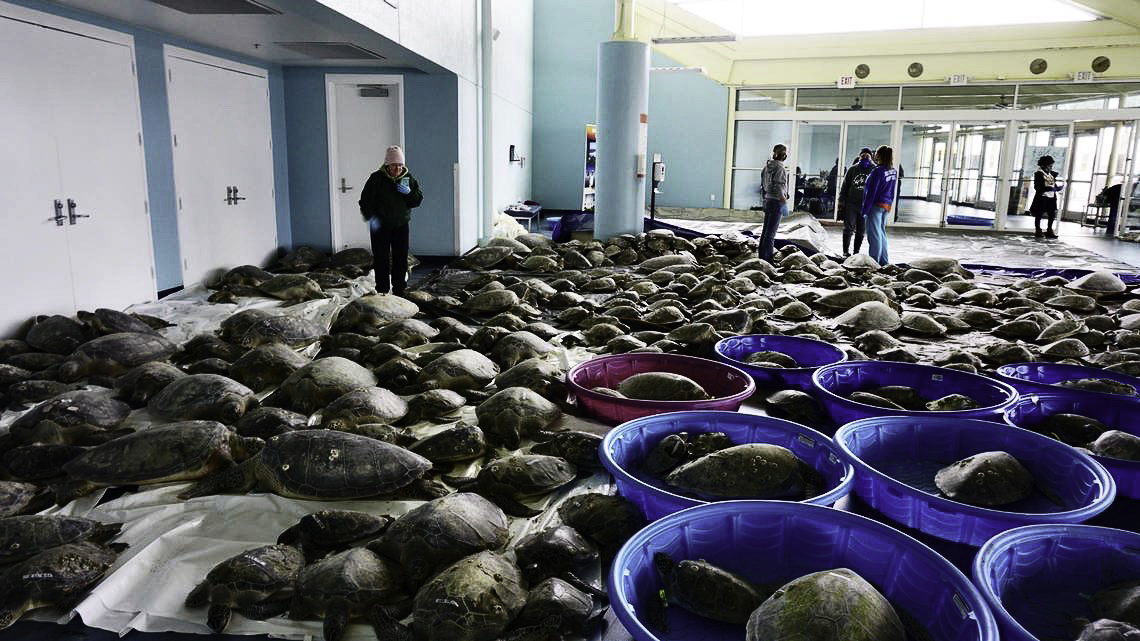
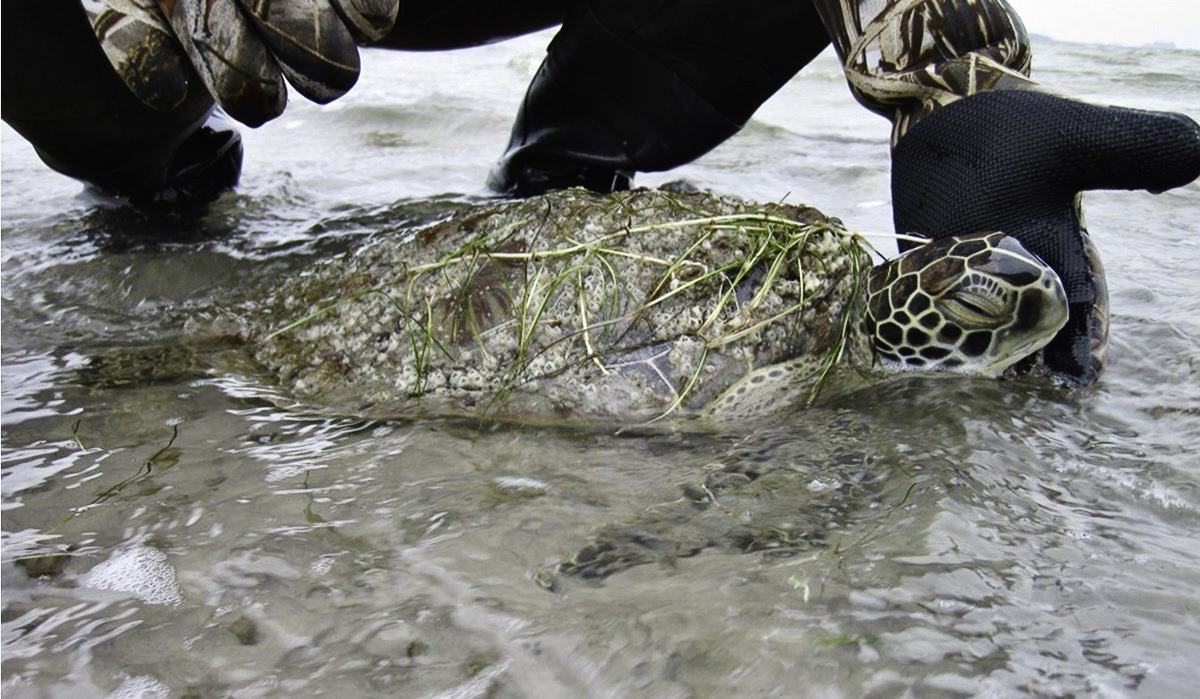
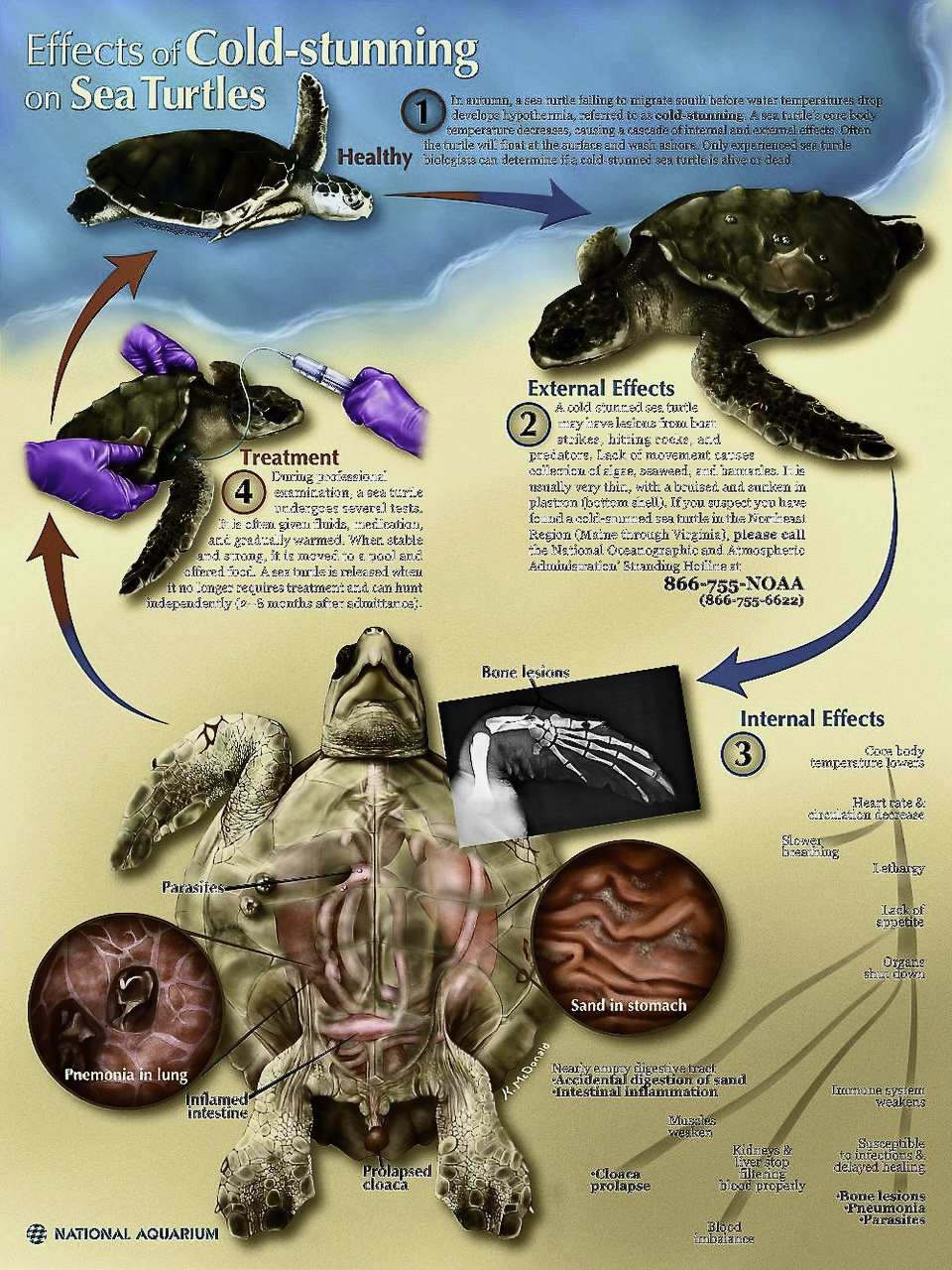
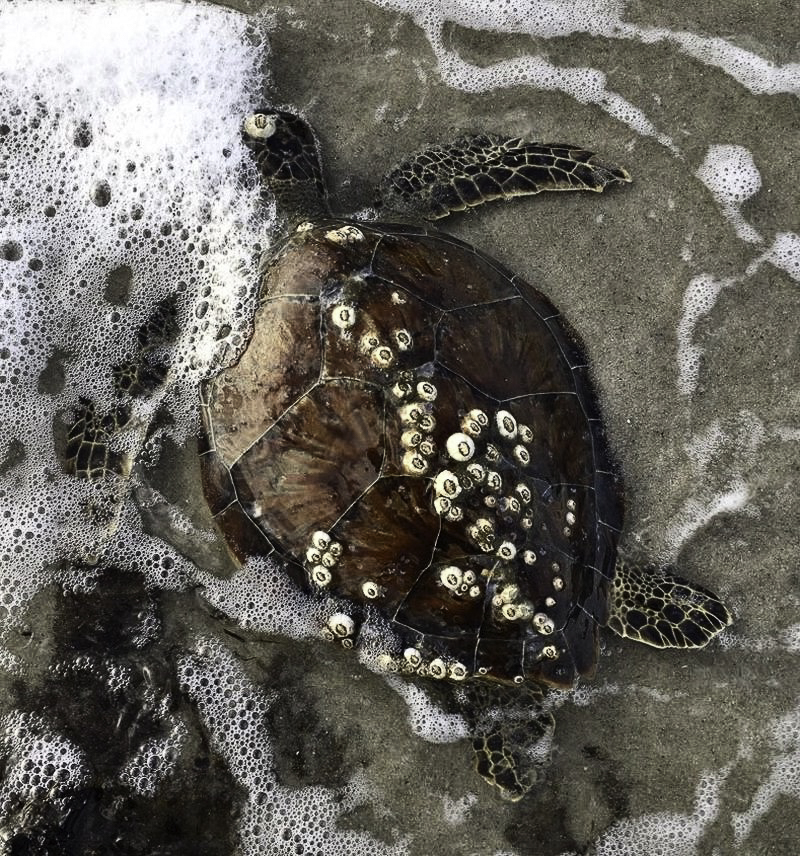
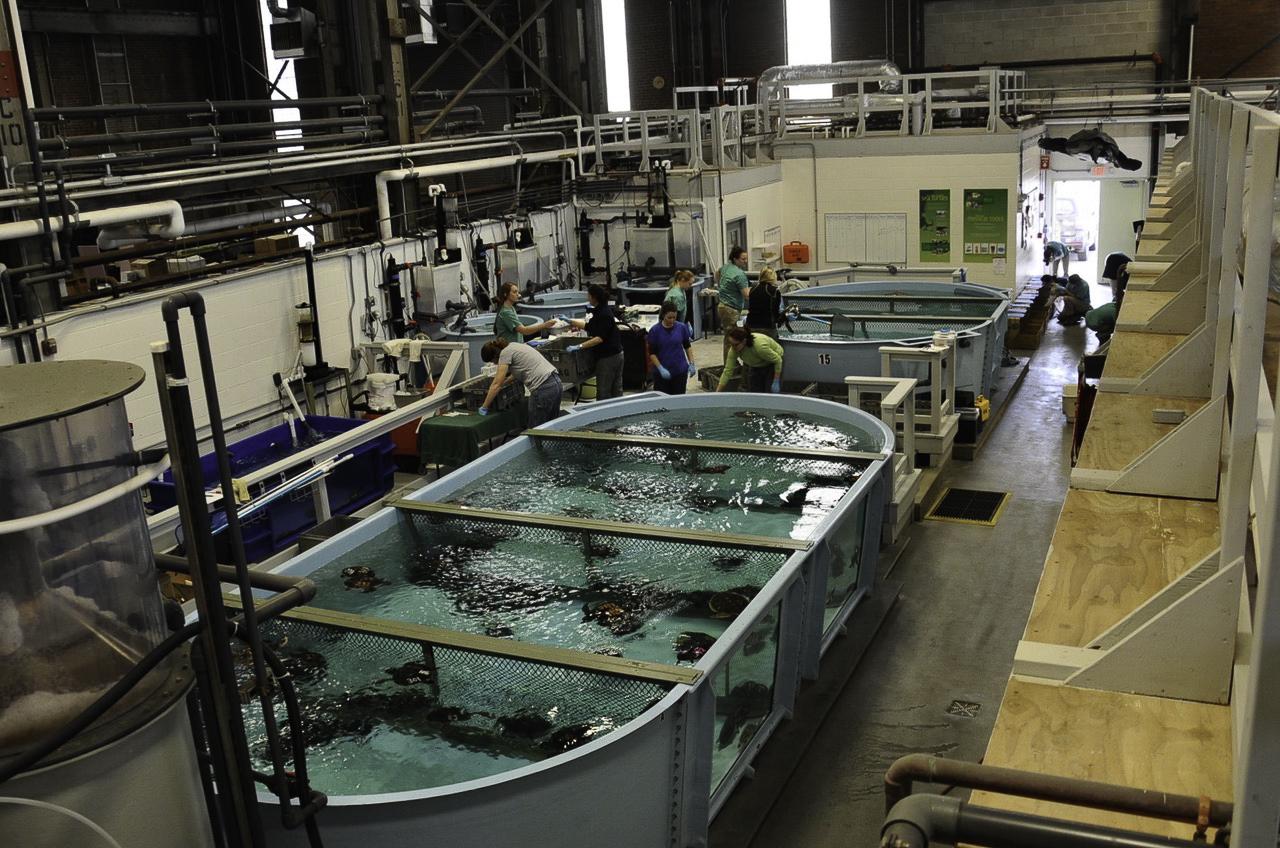
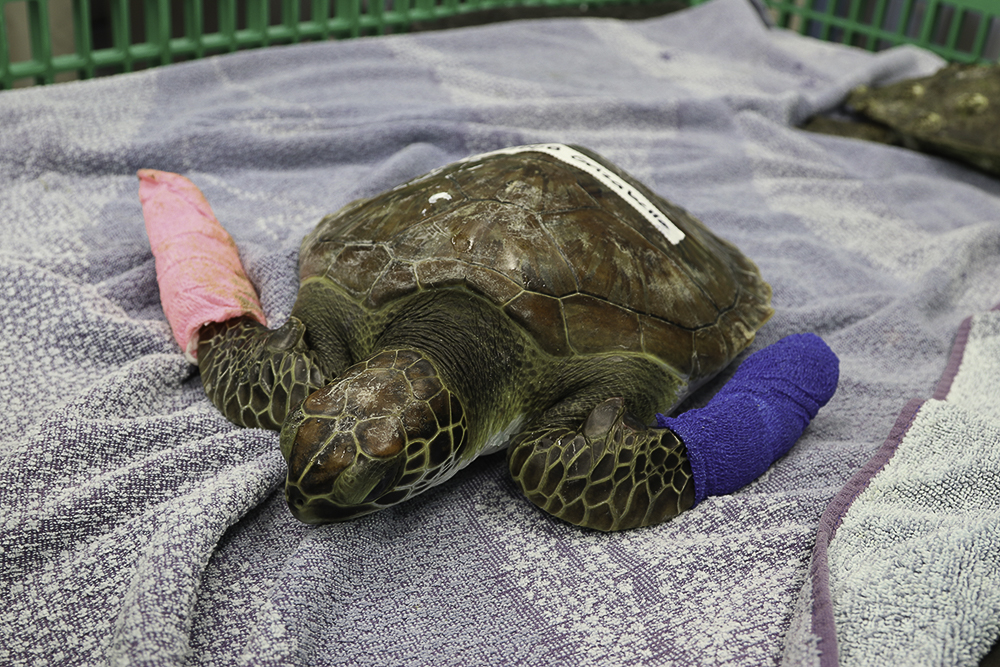
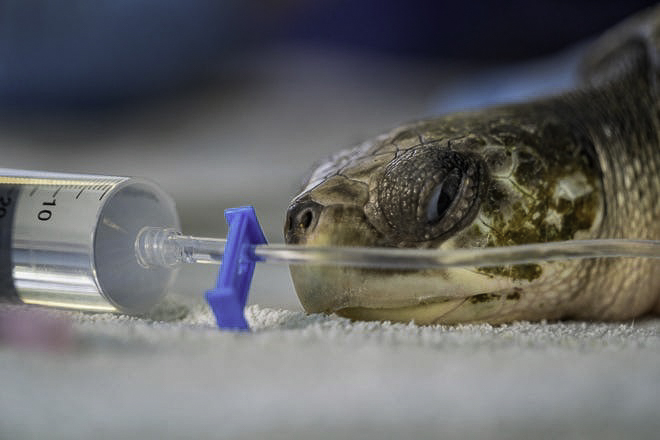
blessings to all the people who are trying to save these creatures. I am sad to read this and at the same time, inspired by the goodness in so many people to try to help the turtles. this will be happening more and more and they will need our help, as so many creatures (and plants) will.
When this piece aired on the news last night, I immediately thought of you and how this would affect you. Such a sad situation! I’ll continue to follow their progress.
Wow, I never knew! Thanks Audrey for another learning opportunity and interesting episode.
Just 🙁
Oh my! Amazing, the interrelation between the coasts, warming waters, and stunning cold! Thanks for another fascinating story.
Miss you oxo
What an amazing story, especially on the heels of your last ePostcard. So much heartbreak, yet so much hope wrapped up in the plight of the sea turtle. To know there are such good people working to save them day to day and during such a catastrophic event is uplifting, and to have you shedding light on both is a gift and an inspiration. Thank you Audrey!
My thanks to everyone for your kind words and interest! One of the sad things about cold stunning is that we only see those who strand or are rescued at sea. The mortality rate is is far more shocking because untold numbers die at sea during these events.